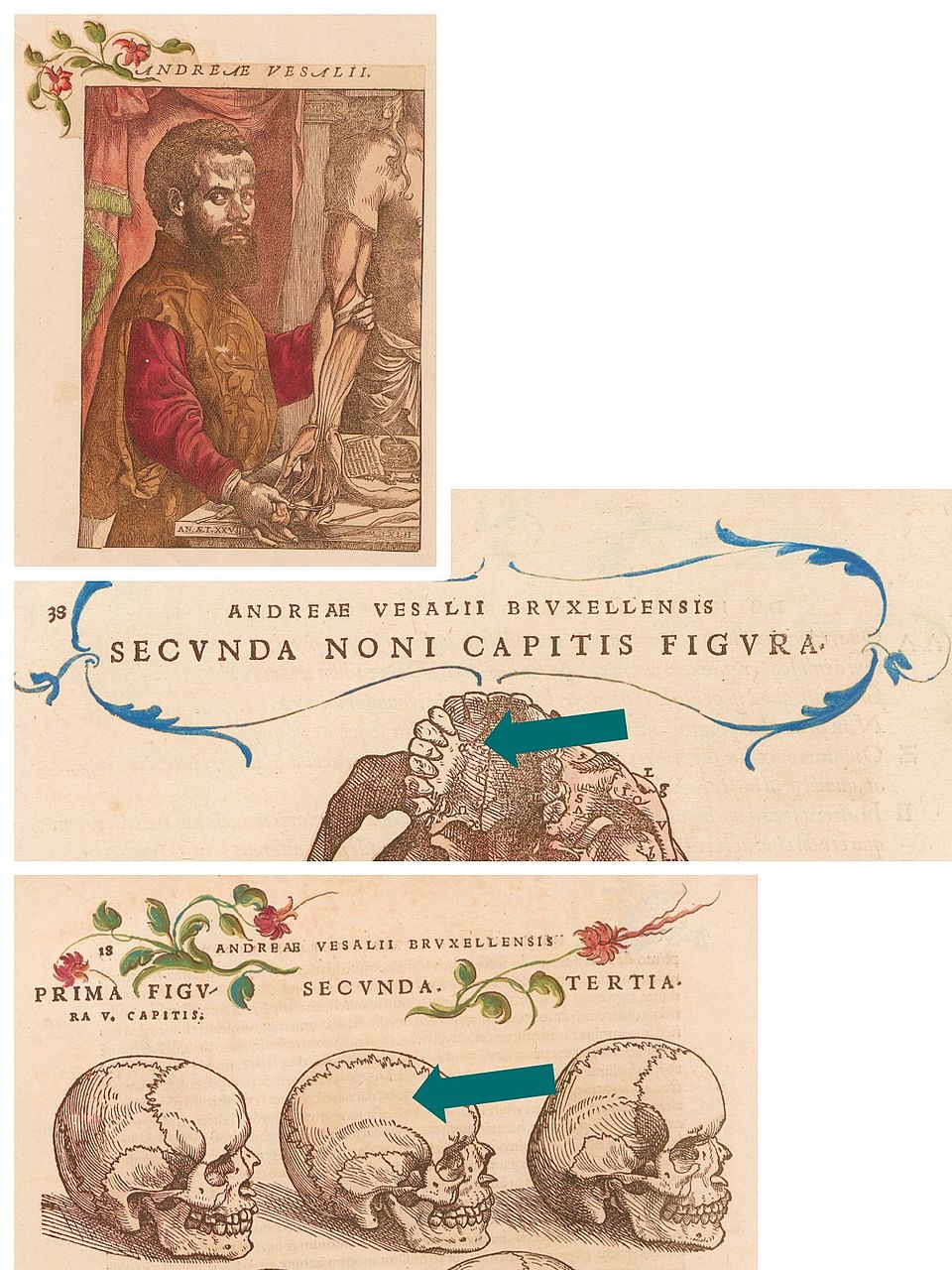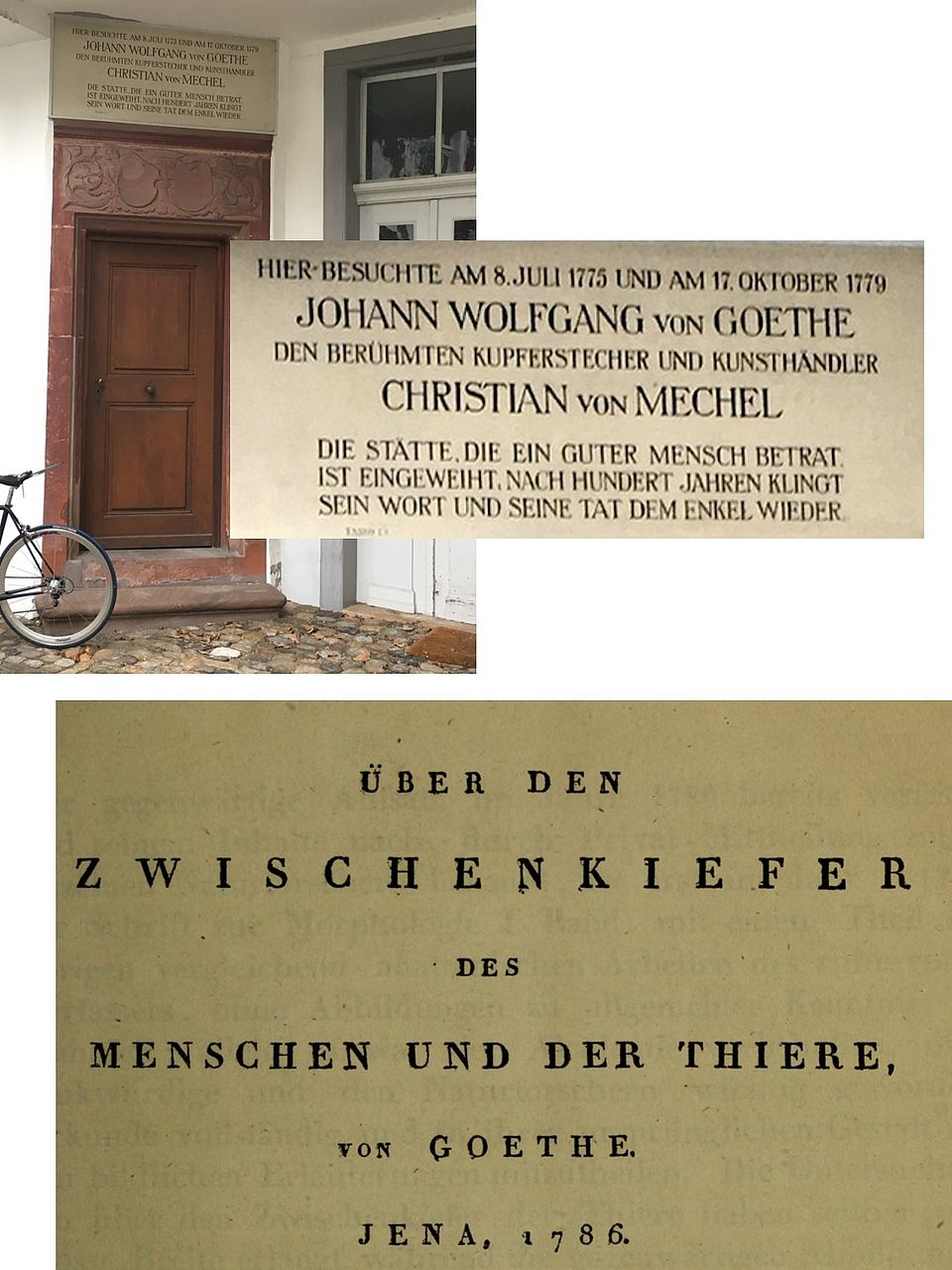History - Basel cleft surgery since 1734
Continuously improving the care for patients with cleft lip and palate malformation has been a joint effort of generations of specialists in Basel – impossible to report in completeness.
However, while working on the next generation of cleft care, the knowlege about the past guides us the way towards future. Here we share with you several selected steps of cleft care history in Basel.
Andreas Vesalius’ comprehensive anatomy atlas, De Humani Corporis Fabrica Libri Septem was printed in Basel in 1543. This was 83 years after the foundation of the University Basel. He described the entire anatomy with over 700 pages of elaborate illustrations, based on his own observations made in human dissections. He refuted more than 200 descriptions of the anatomical teachings of Galen of Pergamon (150 BC), who was deemed faultless by the Church at the time. Vesalius layed the foundation of modern medical anatomy and science through critical observation.
He illustrated correctly, that the bone adjacent to the front teeth (intermaxillary bone) shows a bony connection line to the rest of the jaw (intermaxillary suture). A missing bony connection in this region leads to a cleft.
He also described the abnormal skull shapes that develop when the normal cranial sutures ossify too early, preventing the symmetrical growth of the head - a clinical picture that we now call craniosynostosis.
Since 2014, on the occasion of his 500th anniversary, a translated edition from Latin into English of the atlas has been available. This was made possible by the Karger Verlag in Basel.
Figures: https://doi.org/10.3931/e-rara-20094

Andreas Vesalius' comprehensive anatomy atlas, De Humani Corporis Fabrica Libri Septem was printed by the publisher Johannes Herbst (Oporinus).
Where the first edition was printed in Basel is not entirely certain - however, there is certain evidence that the second edition was printed in 1555 in the Schöne Haus (Beautiful House) at Nadelberg 6 in Basel. The Schöne Haus was built in the second half of the 13th century. The roof dates back to around 1270.
Today the house belongs to the city of Basel and is used by the University.
Figures:
https://wellcomecollection.org/works/ts43xw5v
http://query.staatsarchiv.bs.ch/query/detail.aspx?ID=480816
https://english.philhist.unibas.ch/en/studying
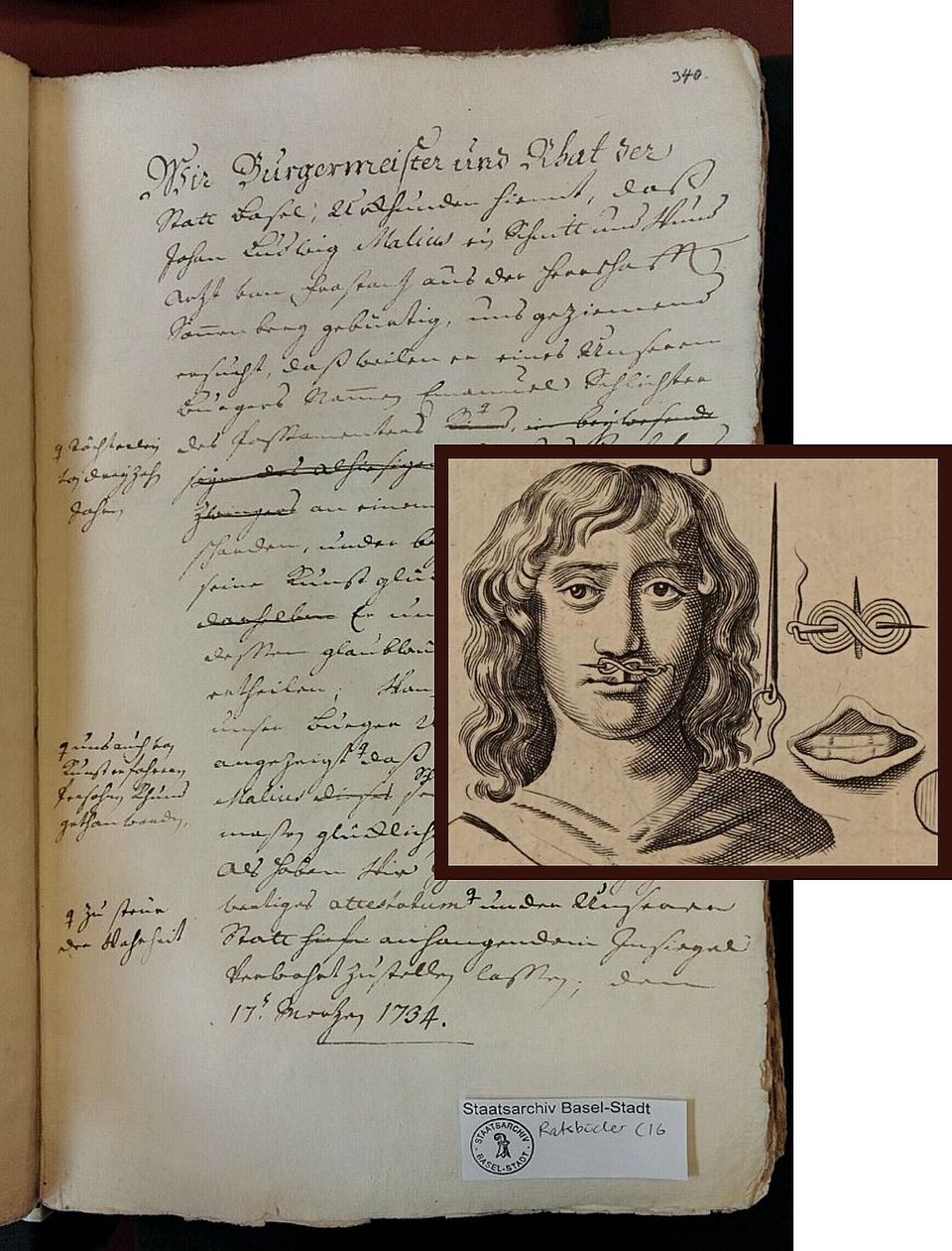
Exactly when the first cleft lip and palate operation took place in Basel is not known. However, it is known for certain that a cleft lip was successfully operated in 1734 in Basel. At that time, the lip was held together with a needle and a looping thread.
In the Basel State Archives Document Book XVI. fol. 340, it is written: Mayor and Council of the City of Basel issue a certificate to the operator Malius von Frastenz on the successful operation of a cleft lip, 17.3.1734.
Figures:
http://query.staatsarchiv.bs.ch/query/detail.aspx?ID=887546
https://wellcomelibrary.org/item/b30323046
Although Andreas Vesalius illustrated 200 years earlier that there is a bony connection line between the bone of the anterior teeth and the rest of the jaw, thie knowledge was not accepted in the 18th century. Because in humans, unlike in mammals, this connecting line is no longer visible in the adult skull, this was considered rather as a distinguishing feature between humans and mammals.
It was Johann Wolfgang von Goethe’s anatomical publication about the “intermaxillary bone” in 1786, which brought this connecting line of the jaw bones back into consciousness, and with it the connection between humans and mammals. This was almost a century before Charles Darwin's "The Descent of Man" appeared in 1871.
Johann Wolfgang von Goethe visited the publisher and engraver Christian Mechel, in Basel, during his Swiss travels in 1775 and 1779 . The door is on the building in the rear courtyard of Spitalstrasse 12, Basel. The building is used by the Department of Clinical Science, University Hospital Basel.
Figures:
Foto A. Mueller
https://wellcomecollection.org/works/uudavqq7

Auguste Socin became a full professor of surgery in Basel in 1864. He was the first full professor that cared exclusively for the surgical field. He was invited to the founding of the German Society of Surgery on 10th of April 1872, at the Grand Hotel de Rome, Unter den Linden 10, Berlin (figure, photography between 1908 and 1910), but could not join that day. At the 25th anniversary of the society, Trendelenburg noted: "Some men joined the Society, but were unable to come, who were then among its main supporters, such as the youthful Dorpat Professor Ernst Bergmann, ... Czerny, Esmarch, ... Socin - Basel, the fine Swiss aristocrat..."
Bernhard von Langenbeck, professor of surgery at the Charité Berlin, became the first president of the German Society of Surgery. Langebeck had devised for the first time a reliable technique to close the hard palate, 11 years earlier in 1861.
Thus, cleft surgery was always a lively topic of discussion among the general surgeons at that time (Chapter 27 and 28).
Figures:
Auguste Socin von H. Speiser Basel. In: Nachruf vorgetragen an der Gedenkfeier in der chirurgischen Klinik am 27.1.1899 von Carl. S. Haegler
https://de.wikipedia.org/wiki/R%C3%B6mischer_Hof
https://wellcomecollection.org/works/gf8cg2b6
https://wellcomecollection.org/works/qbvt74nh
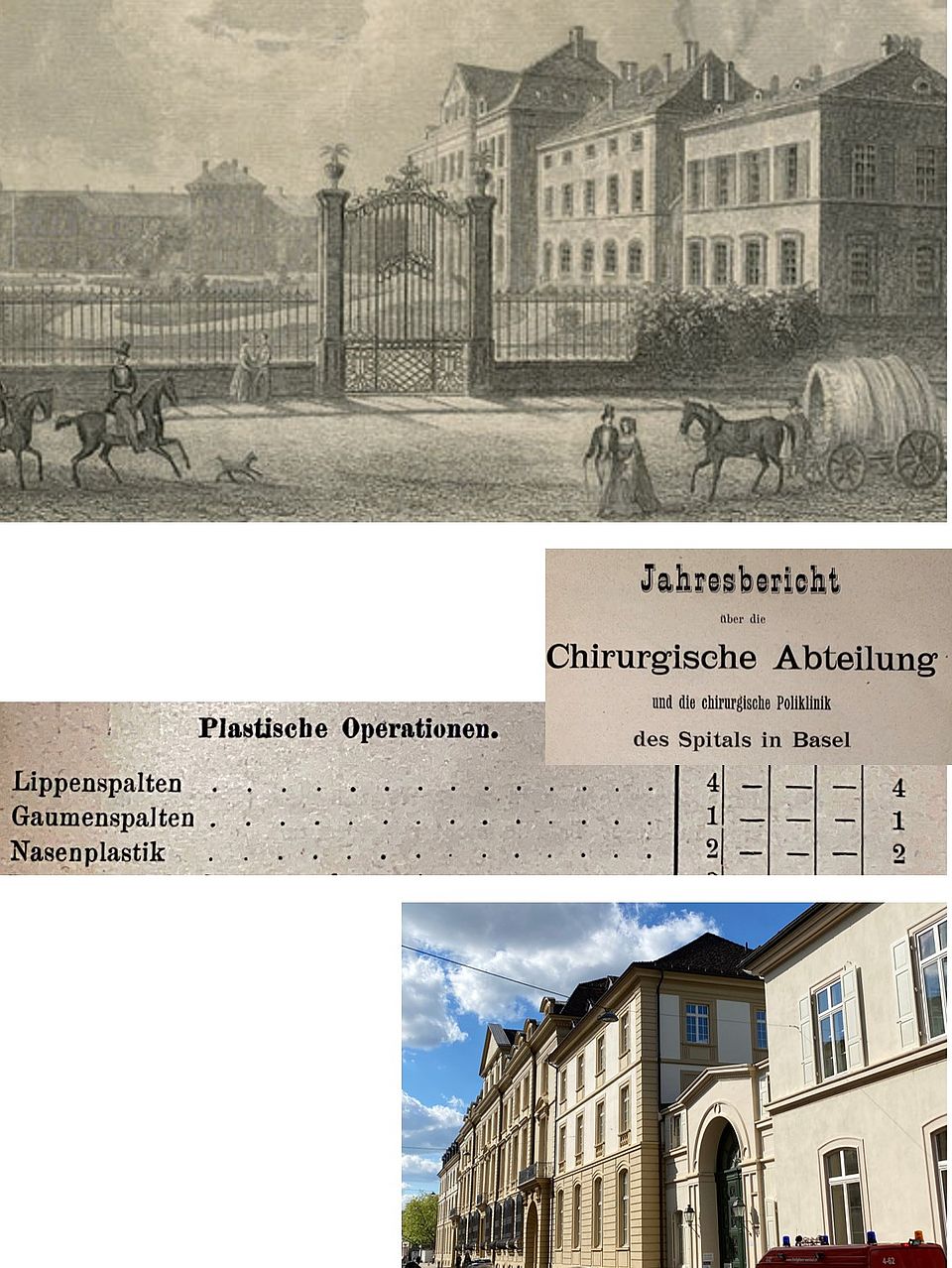
The Markgräflerhof (built 1698 - 1705) was acquired by the city of Basel in 1808 and served as part of the Bürgerspital from 1842 (figure, painting from 2.1.1845).
Auguste Socin (1837-1899) worked here and regularly operated on patients with cleft lips and palates. Today, the consultation hours for patients with cleft lip and palate still take place in the same building.
He discussed his results of cleft lip and palate operations with his colleagues at the annual German Surgical Congresses. For example at the congress in 1873 the fact of variable speech outcome after palatal repair was debated, where it was noted: “Socin had similar experiences and believed that the difference was caused by the different good development of the musculature under otherwise identical conditions. Also, the Passavant's bulge appears very different in different people. Much can be expected from continued practice and rational gymnastics, of which even the best language teachers have hitherto had little understanding.”
Figures:
https://en.wikipedia.org/wiki/Markgr%C3%A4flerhof
Auguste Socin von H. Speiser Basel. In: Nachruf vorgetragen an der Gedenkfeier in der chirurgischen Klinik am 27.1.1899 von Carl. S. Haegler
Foto: A. Mueller

Wilhelm His Sr. (1831-1904) was a professor of anatomy and physiology in Basel from 1857 to 1872. He then assumed an appointment as a professor at the University of Leipzig in 1872. He conducted intensive research on embryology, namely the craniofacial development.
He also developed a microphotographic apparatus with which he was able to take embryological pictures at a high magnification. In 1892 at the annual meeting of the Swiss Natural History Society at the Bernoullianum in Basel, he demonstrated such images during his lecture on "The Development of Human and Animal Physiognomies".
Figures:
https://query.staatsarchiv.bs.ch/query/detail.aspx?ID=399579
https://wellcomelibrary.org/item/b22380760x
https://wellcomelibrary.org/item/b2171082x
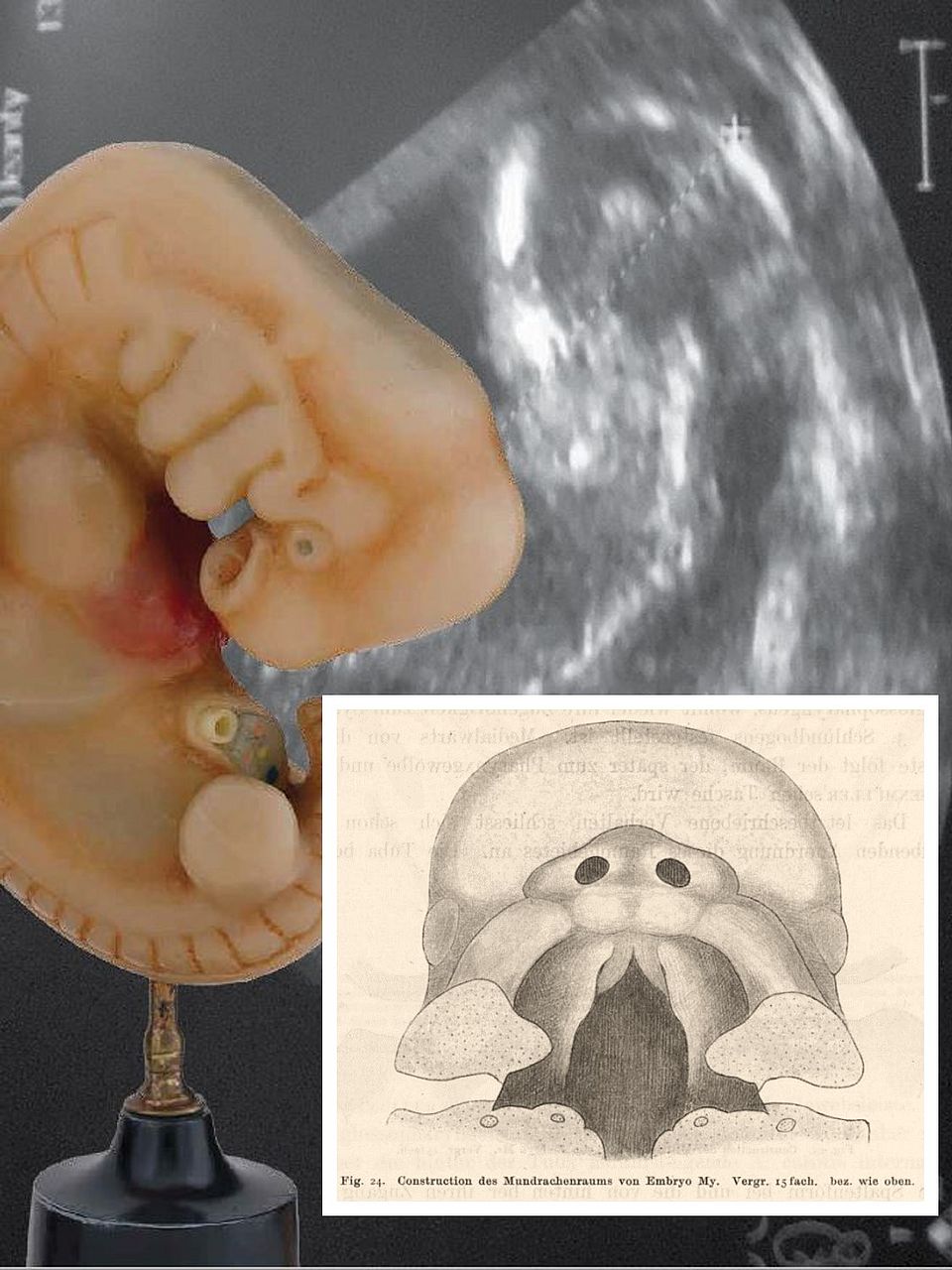
Wilhelm His also perfected a method of enlarging embryos into models made of wax. By making such models of embryos at different stages of development, he was able to visualise the complicated spatial formation of the mouth and nose region.
This was a key to understanding the origin of cleft lip and palate as a malformation that occurs when normal development of the mouth and nose region stops at a certain point in time, while the tissue around it continues to develop normally, thus becoming spatially deformed.
In 1901, he published "Observations on the History of Nose and Palate Formation in the Human Embryo" which greatly contributed to the understanding of the development of cleft lip and palate.
Figure:
https://digital.slub-dresden.de/werkansicht/dlf/1856/1/
https://issuu.com/unibasel/docs/uninova_122_d_130906_def.es/23
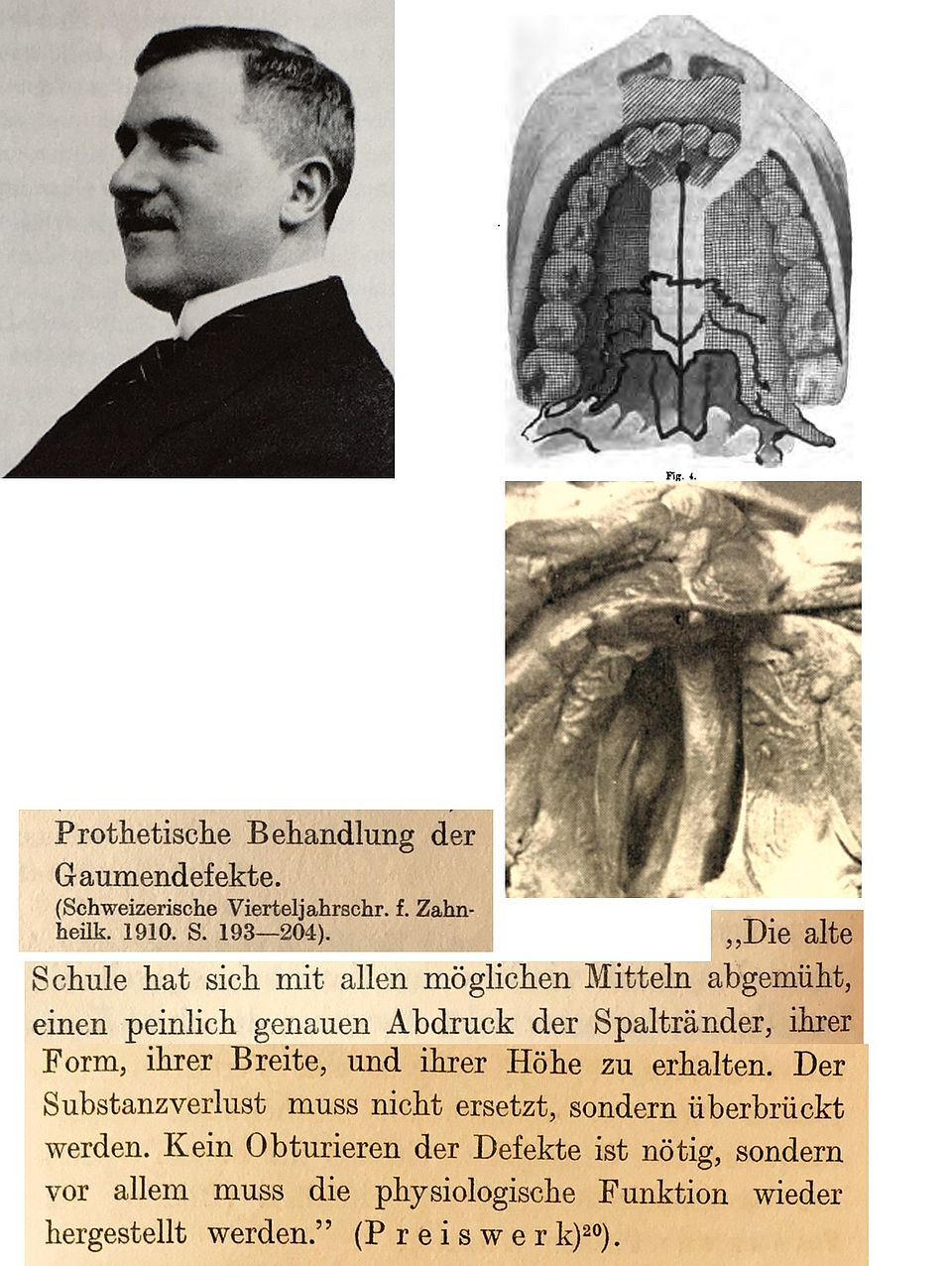
PD Dr. med. Paul Preiswerk (1879-1921) became the first private lecturer in dentistry at the University of Basel in 1912. He was a medical doctor specialised in dentistry.
The Dental Medicine of the University of Basel was founded in 1924, 3 years after his untimely death. Notably, the oldest University in Switzerland has the youngest University Dental Medicine.
Scientifically, Paul Preiswerk worked on the prosthetic treatment of palatal defects, on the intermaxillary bone and on dental anomalies in clefts. He made it clear that the aim of the therapy is to restore palate function and not to obturate the gap. Restoring the natural function is still today the key principle for cleft treatment.
He noted: "The old school has struggled with all possible means to obtain a scrupulously accurate imprint of the cleft margins, their shape, their width, and their height. The loss of substance must not be replaced but bridged. No obturation of the defects is necessary, but above all the physiological function must be restored."
Figures:
Beitrag zur Geschichte der Zahnärztlichen Instituts der Universität Basel. G. Vest. 1967
Die Rolle des Zwischenkiefers bei der Bildung von Zahn- und Kieferanomalien. P. Preiswerk-Maggi. 1908
Die Ursachen der Angeborenen Gaumenspalten nebst Beiträgen zur Anatomie der Gaumen- und Pharynxmuskulatur. Herman Kattenburg. 1917

In 1921, PD Dr. med. Ernst Hagenbach (1875-1946), was appointed as chief physician of the surgical department at the Children's Hospital. He was the first generation which cared exclusively for surgical problems in children. As a student, he was trained by Auguste Socin. He then underwent special training in paediatric surgery and was awarded the venia legendi in 1910.
Hagenbach's scientific publications dealt with a wide range of paediatric surgical problems – but he particularly cared for cleft surgery (example: 1925 about the timing of palatal surgery, 1933 about the protruding premaxilla in unilateral clefts).
The Children's Hospital at the banks of the Rhein opened in 1862 and was replaced by a new building at the same location in 1930. The surgical room was on the ground floor on the east side – ensuring good light in the morning. Good light is the surgeon’s friend.
Figures:
Festschrift Prof. Dr. Ernst Hagenbach. 1945
100 Jahre Kinderspital in Basel: 1862-1962.
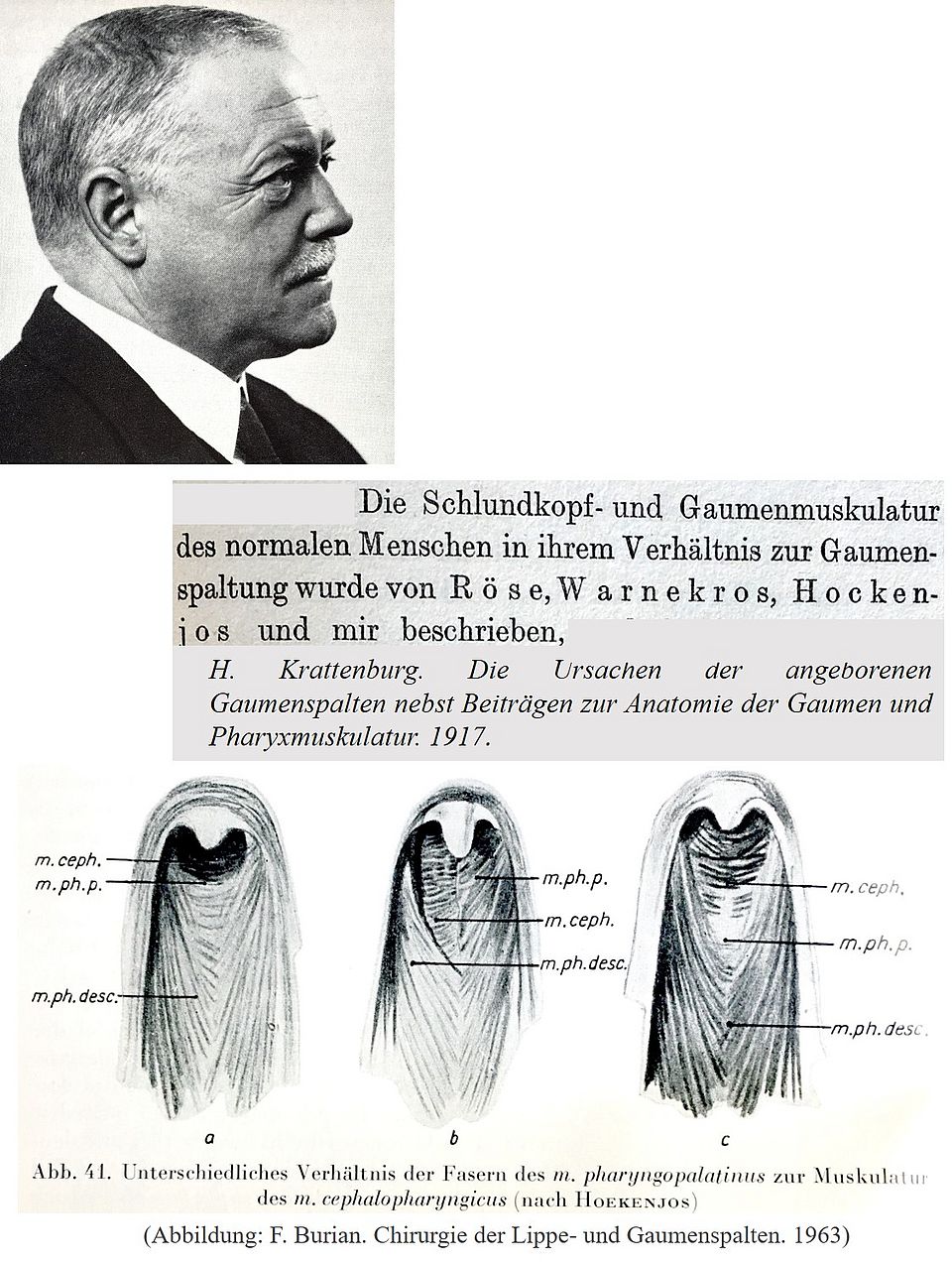
In 1924, Dr. med. Ernst Hockenjos (1872-1949) was appointed as a professor and the first director of the newly founded Dental Institute of the University of Basel. He was the head of the public dental and dental-surgical outpatient clinic.
The medical faculty had long been reluctant to create an independent University dental school. For many years, prospective dentists were trained in private dental practices of medical doctors. This was also the case from 1921-1924 at the "Privates Institut und Volkszahnklinik Hockenjos". This was located at Leonardstrasse 24, where at the time, 10-20 students could be taught each year.
Scientifically, Ernst Hockenjos contributed to the research on the pharyngeal musculature in normal anatomy and on cleft palates malformations as well as on palatal obturators to improve speech in palatal defects. His work was included in important standard works on cleft surgery over the next decades (e.g. Burian F., Chirugie der Lippen- und Gaumenspalten).
Figures:
Beitrag zur Geschichte der Zahnärztlichen Instituts der Universität Basel. G. Vest. 1967
Die Ursachen der Angeborenen Gaumenspalten nebst Beiträgen zur Anatomie der Gaumen- und Pharynxmuskulatur. Herman Kattenburg. 1917
Chirurgie der Lippen- und Gaumenspalten. F. Burian. 1963
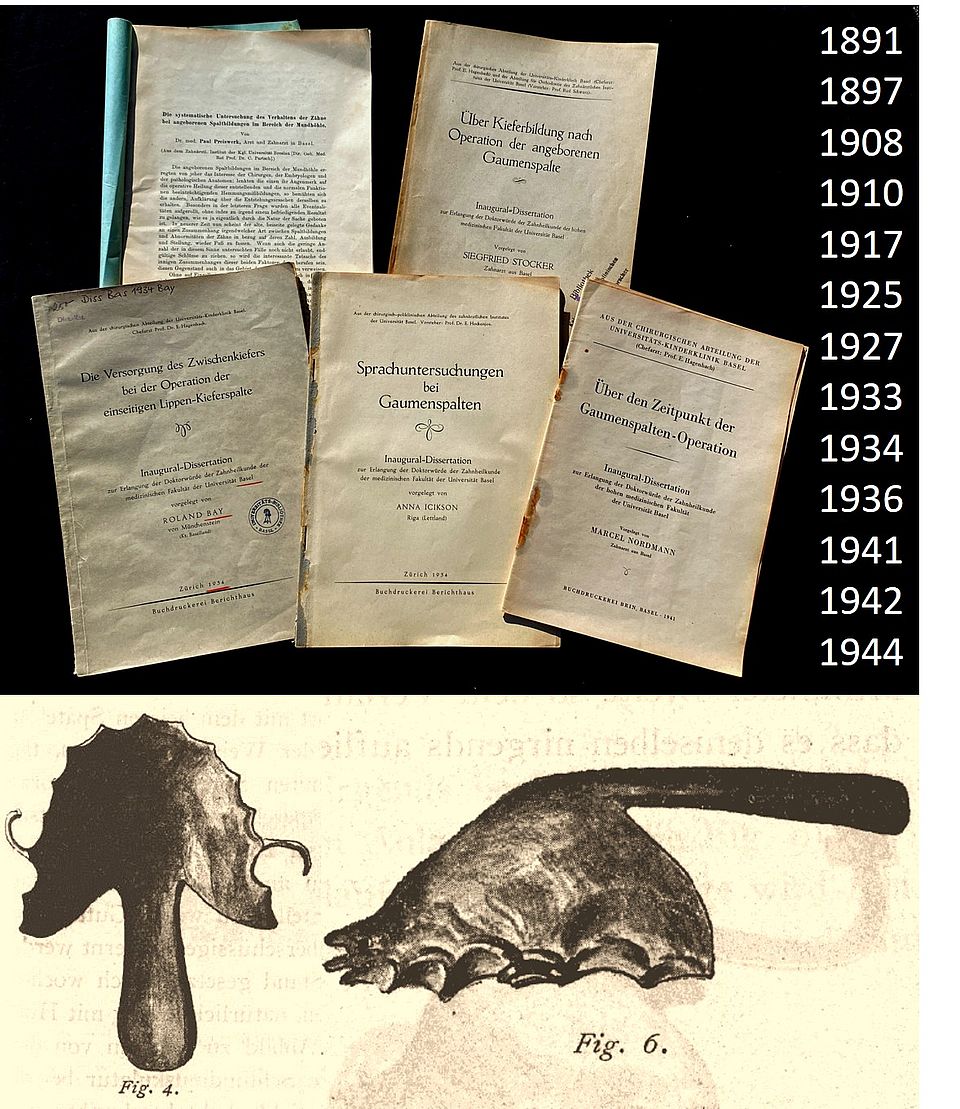
At the beginning of the 20th century, close cooperation between dentistry and paediatric surgery in Basel resulted in a series of pioneering publications in the field of cleft lip and palate. Much earlier than at other places, treatment principles were followed here in Basel that later proved to be correct and now considered as standard.
1908 (Hockenjos):
The velar musculature can be strengthened by specific speech therapy.
1910 (Preiswerk):
The palatal plate needs to just cover the defect but not obturate. Restoration of function is a key.
1910 (Preiswerk):
Dental eruption in clefts needs a close follow-up to resolve eruption blockage and prevent tooth position anomalies.
Figures:
Foto A. Mueller
Prothetische Behandlung der Gaumendefekte. P. Preiswerk-Maggi. 1891.

1927 (Stocker / Hagenbach):
Jaw growth is reduced especially when nasal breathing is difficult and mouth breathing is present. Jaw growth is strongly dependent on the forward-movement and eruption of permanent teeth. The interruption of the alveolar arch by the alveolar cleft forms an obstacle to the jaw growth.
1934 (Bay / Hagenbach):
The skeletal distortion is best restored by simple restoration of the natural muscle function of the lip. No early bony operation is performed to restore the anteriorly distorted intermaxillary bone, that contains the front teeth. The selected surgical technique needs to be as little extensive as possible to achieve a correct function and to allow a spontaneous normalization of the distorted skeleton.
Figures:
Foto A. Mueller
Die Versorgung des Zwischenkiefers bei der Operation der einseitigen Lippen-Kieferspalte. Inaugural Dissertation. Universität Basel. R. Bay. 1934.
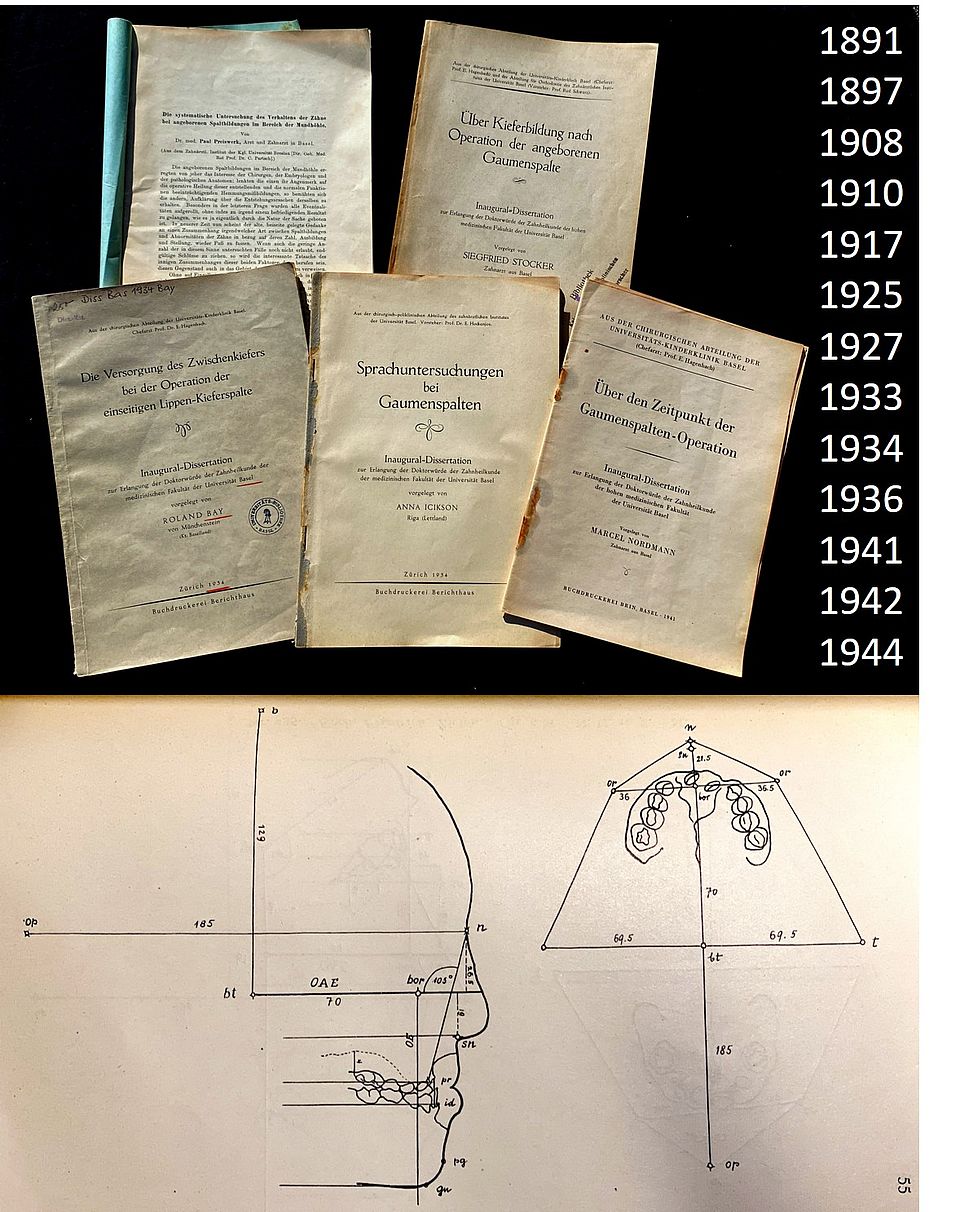
1934 (Ickinson / Hockenjos):
The Levator muscle is the most important muscle for speech. The Uvula has minor importance for speech. Early (before 1 year) palatal surgery is beneficial for good speech.
1941 (Nordmann / Hagenbach):
Palatal operation in the first year of life can be safely achieved. (explication note: At that time, the children were sedated with Aether, but breathing was spontaneous without a ventilating machine while the palate was operated. The children were not intubated) …….Postoperatively, the child can be fed immediately with liquids. No dressing plate, no feeding tubes are used………The surgical timepoint, however, always needs to be selected so as to assure the best results for primary healing. The foremost importance is to achieve an undisturbed healing in the first operation.
Figures:
Foto A. Mueller
Über die Kieferbildung nach Operation der angeborenen Gaumenspalte. Inaugural Dissertation. Universität Basel. S. Stocker. 1927.
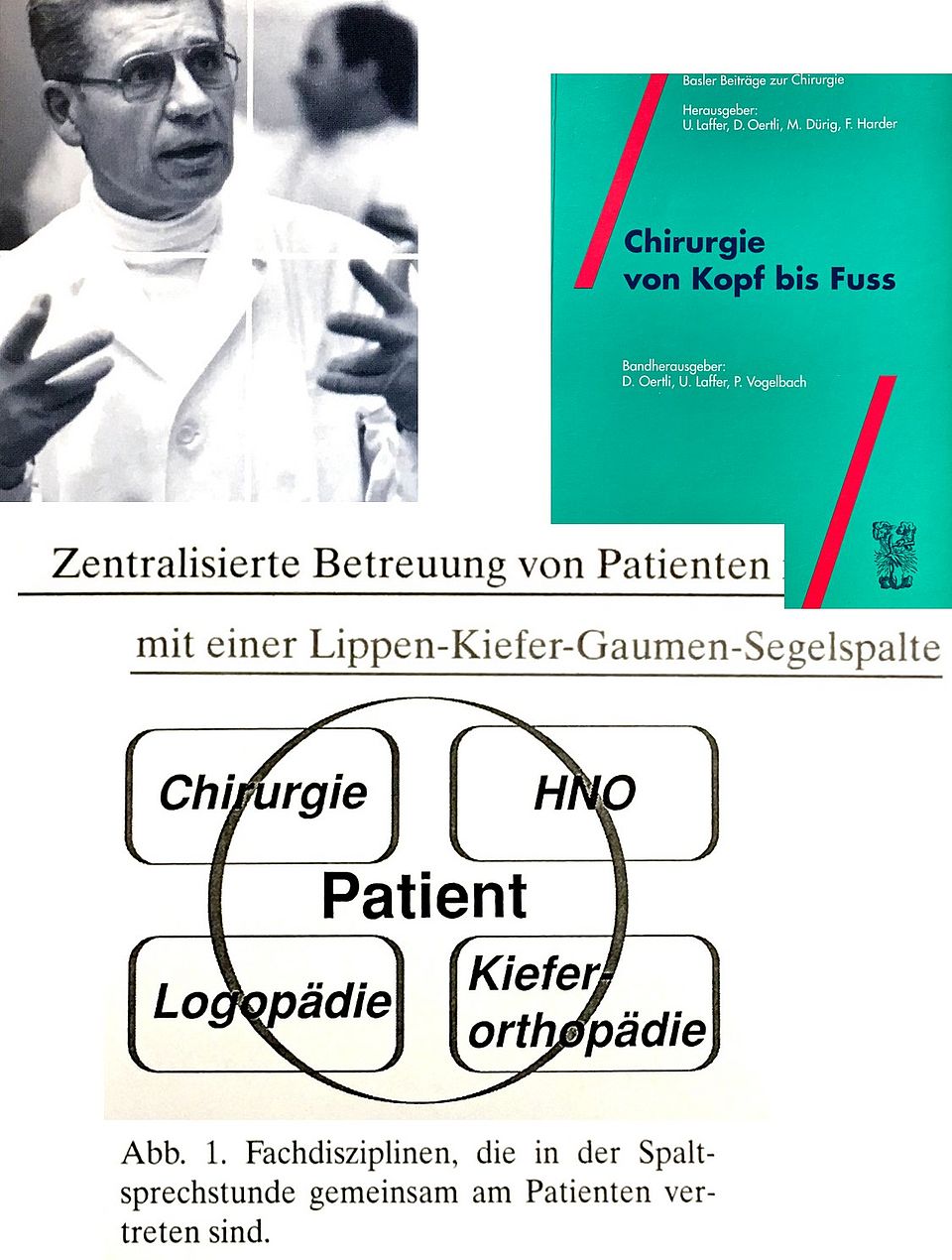
In 1965, Prof. Dr. med. Dr. med. dent. Bernd Spiessl (1921-2002) was appointed the first chief physician of the newly created Unit of Oral and Maxillofacial Surgery at the Surgical Department of the University Hospital Basel.
Spiessl received his maxillofacial surgical training under Prof. Schuchardt in Hamburg Eppendorf. In his medical doctoral thesis (1960), he reported about the experiences on general anaesthesia for cleft lip and palate surgery in early childhood and infancy.
He brought this knowledge to the team of paediatric surgeons responsible for cleft surgery then and in the following years (PD Dr. Nicole and Mrs. Dr. Kummer). With the ongoing sub-specialization of all surgical fields, cleft surgery shifted gradually from paediatric to maxillofacial surgery.
Prof. Spiessl established a multi-disciplinary cleft outpatient clinic in the 70s, during which the patients and their families were seen jointly by the different specialist (surgery, orthodontics, ENT and speech therapy). Consequently, a well coordinated treatment approach could be agreed for each patient.
Figures:
Bernd Spiessl (1921-2002). Inauguraldissertation. C. Luzzi. 2005
Zentralisierte Betreuung von Patienten mit einer Lippen-Kiefer-Gaumenspalte. In: Chirurgie von Kopf bis Fuss. Oertli et al. 1995
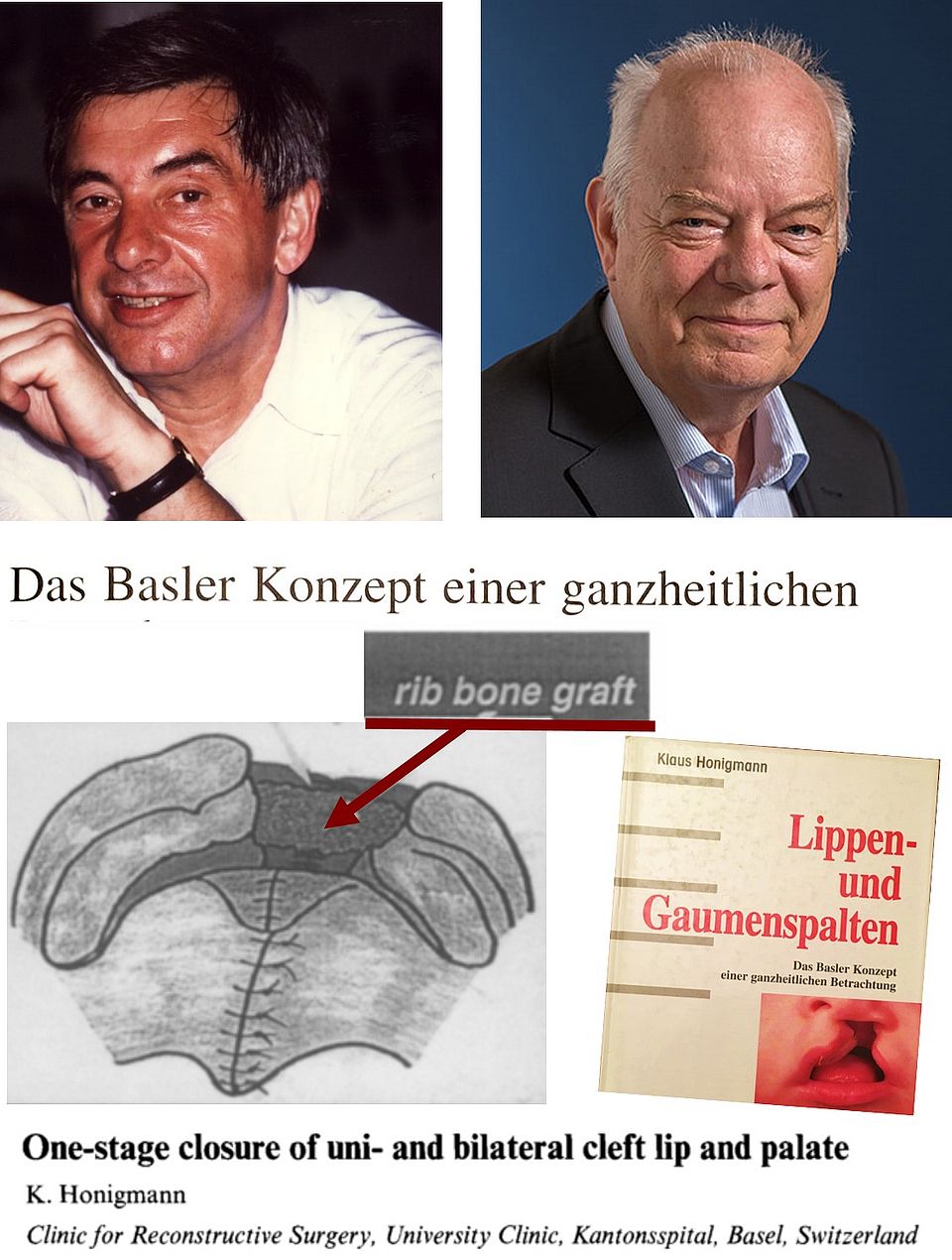
In 1986, Prof. Dr. med. Dr. med. dent. Joachim Prein (figure right) was appointed the head of the Oral and Maxillofacial Surgery at the University Hospital Basel.
Upon his initiative, PD. Dr. med. Dr. med. dent. Klaus Honigmann (figure left) (1943-2006) joined the maxillofacial team in 1990. He brought profound cleft surgical expertise which he had acquired while working for many years at the main hospital for cleft patient in former Eastern Germany in Thallwitz, near Leipzig (Wolfgang Rosenthal Klinik).
With over two-decades of extensive experience in cleft surgery, in 1991 in Basel, Dr. Honigmann started to combine lip and palate closure comprising a bone transplantation from the rip into the alveolar cleft within one surgical procedure – the so called one-stage closure.
He published his comprehensive and patient centered approach on cleft treatment and coined the term “The Basel concept of a holistic approach”.
Figures:
Honigmann, Klaus. 1998. Lippen- und Gaumenspalten das Basler Konzept einer ganzheitlichen Betrachtung.
www.ao-alliance.org.
Honigmann, K. 1996. One-stage closure of uni- and bilateral cleft lip and palate. British Journal of Oral & Maxillofacial Surgery. 34 (3): 214-219.
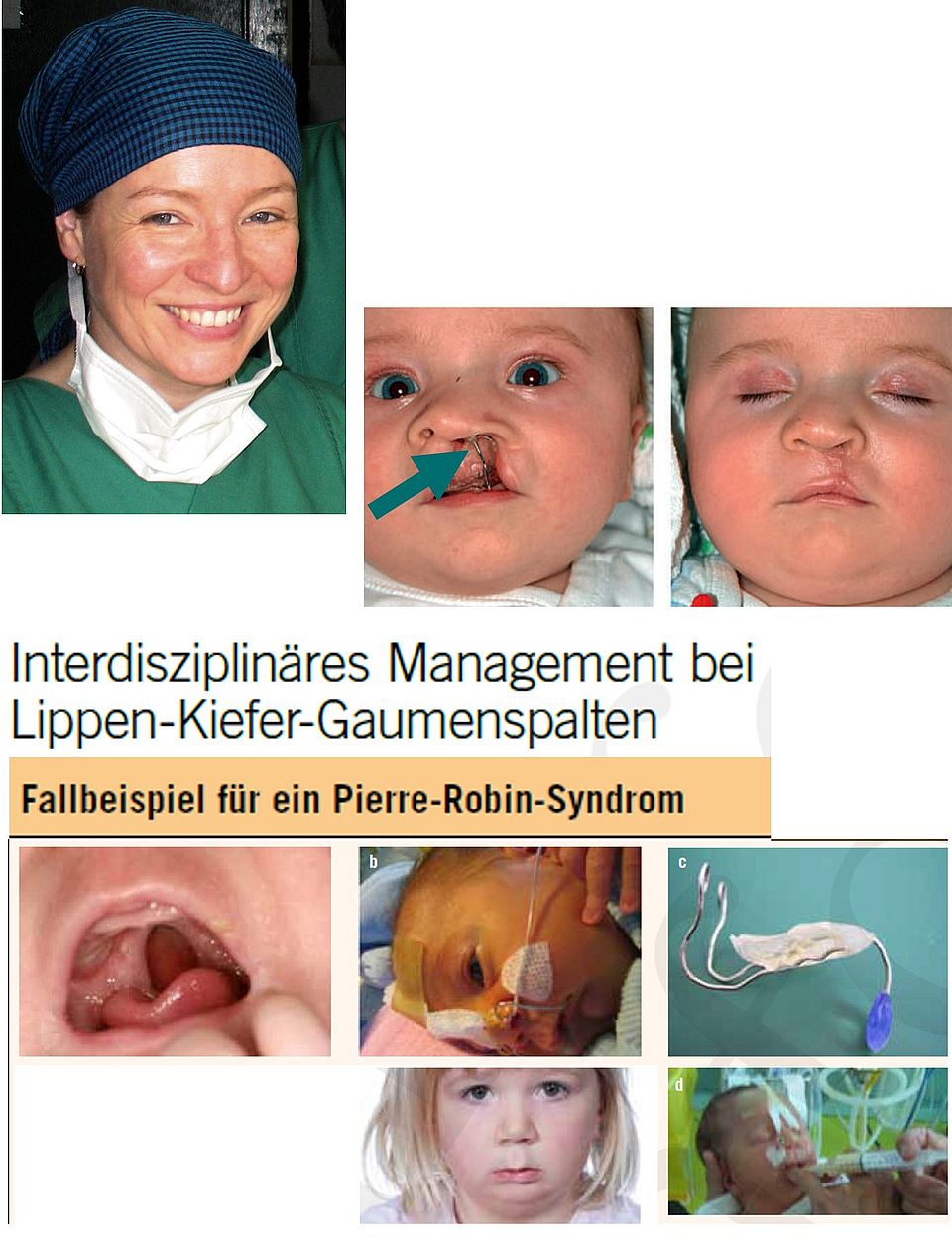
In 2002, PD Dr. med. Dr. med. dent. Katja Schwenzer-Zimmerer became the head of the cleft service at University Hospital Basel, which she led until 2014.
Being convinced by the long-term results achieved by Dr. Honigmann, she continued the protocol of combined repair of lip- and palate in one anesthesia – however, she stopped adding the bone transplantation in the first surgery to make the surgery less extensive.
She initiated the presurgical molding of the flattened wing of the nose on the cleft side by adding a stent to the palatal plate – which helps to achieve better nasal symmetry.
In addition to the cleft palate, some children suffer from a small mandible, leading to breathing obstruction (Pierre Robin Sequence). For these children, she established a special plate therapy (Tübinger Platte) in close relation with the paediatricians to allow normal breathing and feeding after birth.
Figures:
Foto A. Mueller
Schwenzer-Zimmerer, Katja. 2011. Lippen-Kiefer-Gaumen-Spalten - nur ein chirurgisches Problem? Swiss Medical Forum. 2011;11(46):824-829
Interdisziplinäres Management bei Lippen-Kiefer-Gaumenspalten. Schwenzer-Zimmerer K. 2014. (https://tellmed.ch/include_php/previewdoc.php?file_id=12381)

Dr. h. c. Susanne Codoni, who has been a longstanding speech and craniofacial therapist in the cleft team at the University Hospital Basel, developed and launched an advanced studies master course for craniofacial kinetic science together with Prof. Dr. med. Dr. med. dent. Dr. h.c. Hans-Florian Zeilhofer (head of Oral and Maxillofacial Surgery, University Hospital Basel from 2002 – 2019) in 2011.
She has developed the Concept of the Body Oriented Speech Therapy (k-o-s-t) – a therapeutic strategy, which is highly effective in children who have undergone cleft repair. The strategy allows to educate the patients, to train and coordinate the important muscle groups of the face, soft palate and tongue – as well as their interdependent body muscles.
In recognition of her excellent contribution to the therapy for speech and language disorders in children and adolescents, and her extensive teaching activity, she was awarded Doctor honoris causa of the University of Basel in 2011.
Figures:
University of Basel
www.scodoni.ch
Schwenzer-Zimmerer, Katja. 2011. Lippen-Kiefer-Gaumen-Spalten - nur ein chirurgisches Problem? Swiss Medical Forum. 2011;11(46):824-829
https://dbe.unibas.ch/en/persons/hans-florian-zeilhofer/
Funktionsorientierte Logopädie. Springer Verlag 2019. Codoni Susanne, Spirgi-Gantert Irene, von Jackowski Jeannette, A.(Hrsg.) https://www.springer.com/us/book/9783662573310
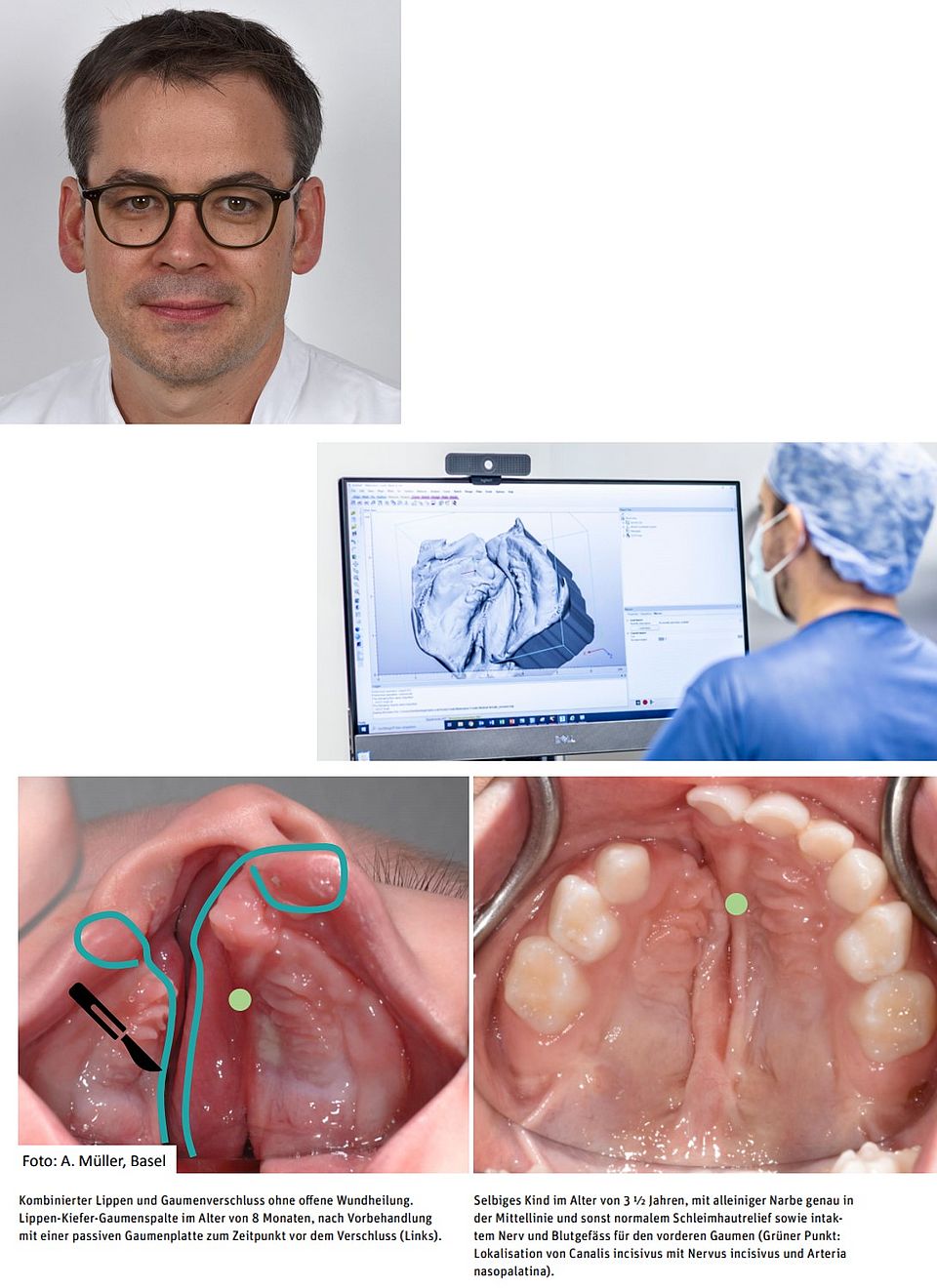
In 2014, PD. Dr. med. Dr. med. dent. Dr. phil. Andreas Mueller, became the surgical head of the cleft service at the University Hospital Basel, after having been in the cleft team since 2004.
He has devised a new strategy to close the lip and palate in one surgery, so that from now on, only a thin scar line exist strictly along the area of intended tissue fusion (dark green lines in the figure, bottom left) but nowhere else. Unlike the previous techniques, it also allows preservation of full palatal sensibility and blood flow (green point, bottom figures) behind the front teeth, known as a key area for speech and jaw growth.
He has tied international partnerships with high case-load cleft centers in Poland (Warsaw, Institute for mother and child) and India (Hyderabad & Chennai) for scientific and clinical exchanges. This has allowed a launch of a Multi-investigator project designed to reduce the burden of cleft care globally in 2019 (Botnar Research Centre for Child Health).
Since 2020, the intraoral impressions for manufacturing a palatal plate that bridges the defect after birth are performed purely with optical scans. Thus, burdensome and riskful intraoral impressions with silicone in the newborn have become obsolete.
Figures:
https://brc.ch/research/cleft-lip-and-palate/
https://lkg-spalte.ch/wp-content/uploads/id_spalte_2020_31.pdf

